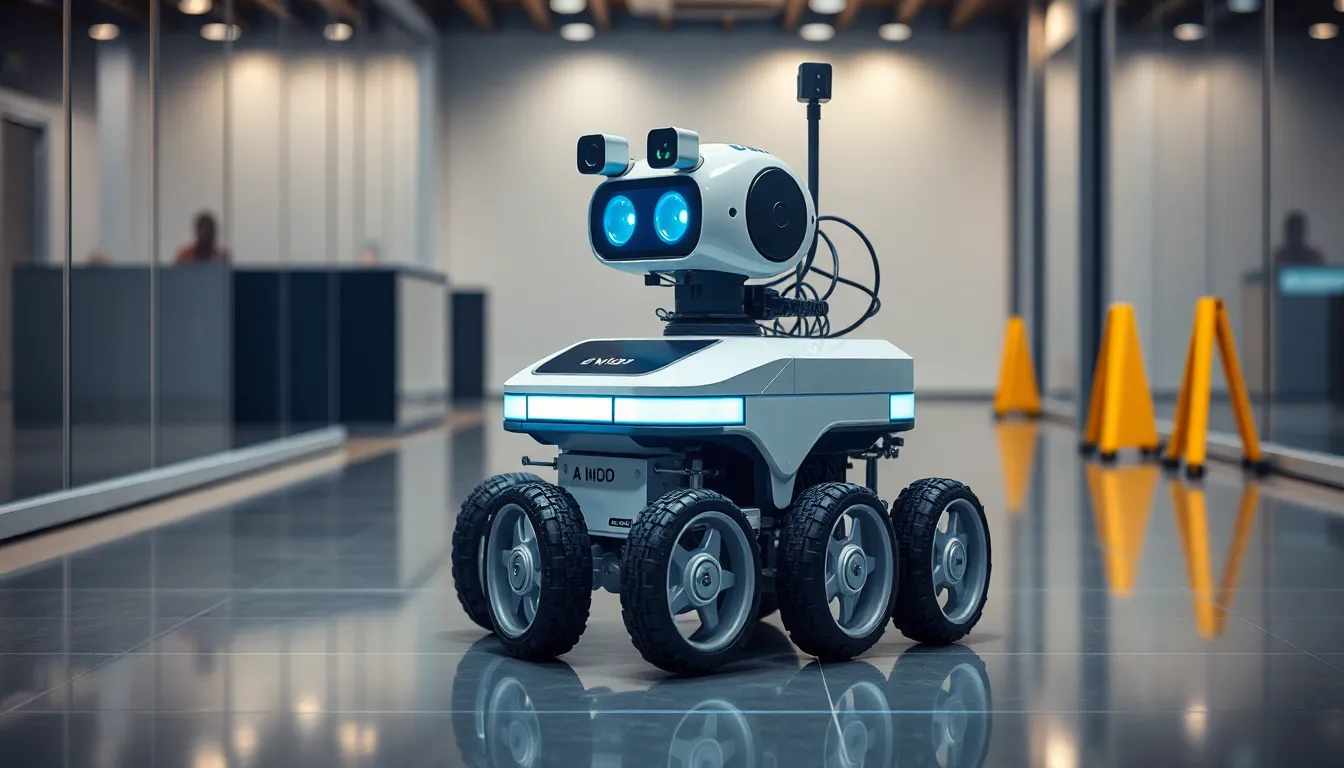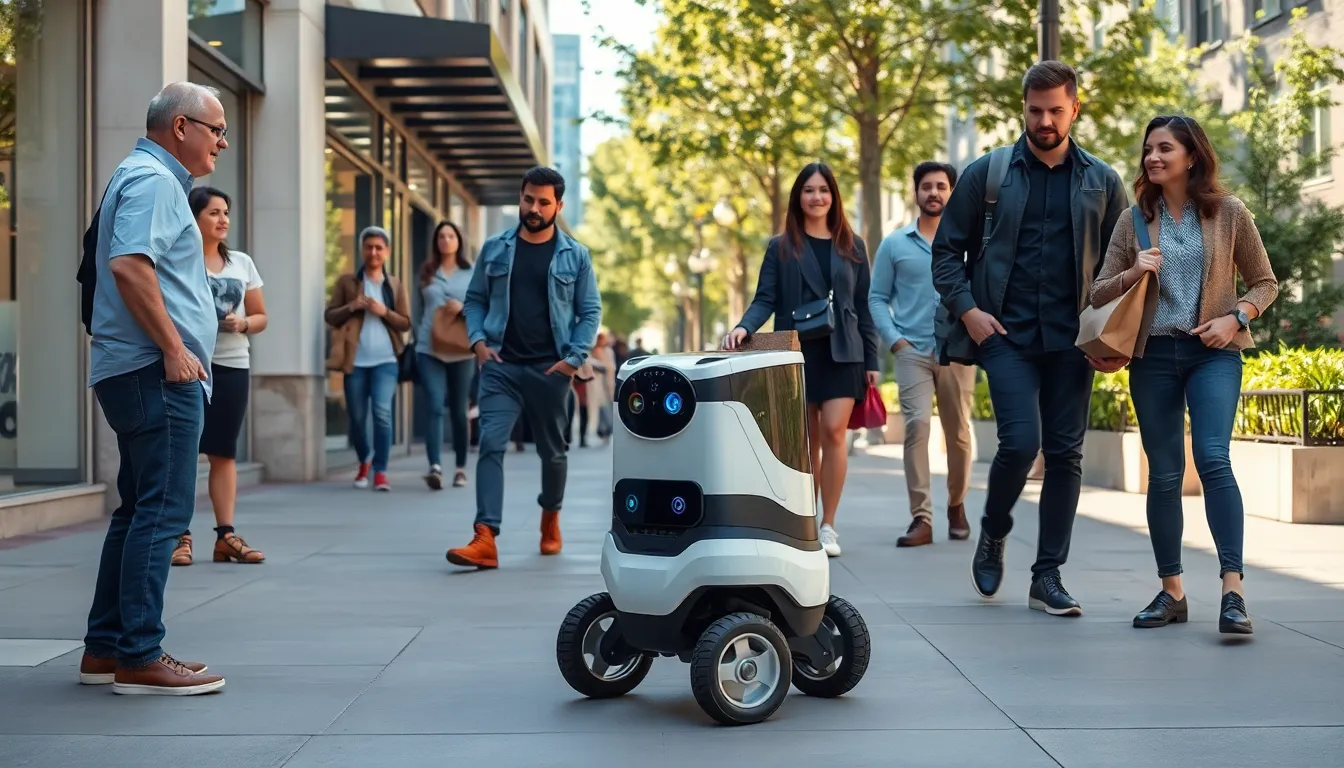In a world where robots can deliver your pizza and vacuum your floors, mobile robotics is the star of the show. These nifty machines aren’t just for sci-fi movies anymore; they’re revolutionizing industries and making life a whole lot easier. Imagine a robot that can navigate your office, dodge obstacles, and even give you a friendly beep—what’s not to love?
Table of Contents
ToggleOverview Of Mobile Robotics
Mobile robotics comprises robots designed to navigate through various environments autonomously. These robots utilize sensors, algorithms, and advanced software to understand and interact with their surroundings. Sensors like LiDAR and cameras gather information about obstacles and terrain, enabling intelligent decision-making.
Autonomous mobility in robots offers numerous applications. For instance, delivery robots transport items in urban settings. In warehouses, mobile robots streamline logistics tasks by moving goods from one location to another. These examples showcase how agile and efficient these machines can be in real-world scenarios.
Industries increasingly deploy mobile robotics to enhance productivity. Manufacturing facilities incorporate robots into assembly lines to reduce human error and speed up production times. Hospitals leverage mobile robots for tasks such as medication delivery and sanitization, ensuring a safer environment for patients and staff.
Integration with artificial intelligence significantly enhances mobile robotics capabilities. AI enables robots to learn from their interactions, improving performance over time. With machine learning algorithms, they can adapt to new tasks and environments, making them more versatile.
Continuous advancements in mobile robotics technology suggest a promising future. Emerging innovations include advanced navigation systems and improved energy sources. As technology progresses, mobile robots are poised to become even more integrated into daily life, transforming how tasks are performed.
Key Components Of Mobile Robotics

Mobile robotics relies on several critical components that enable autonomous navigation and operation within diverse environments. Understanding these components is essential for grasping how robotic systems function.
Sensors
Sensors play a vital role in mobile robotics by providing essential data for navigation and obstacle avoidance. They collect information about the robot’s surrounding environment. Common types include cameras, LiDAR units, ultrasonic sensors, and infrared sensors. Cameras capture visual data, aiding in object recognition, while LiDAR offers precise distance measurements. Ultrasonic sensors detect nearby objects using sound waves. Infrared sensors are valuable for identifying obstacles and facilitating navigation. Together, these sensors allow robots to formulate situational awareness, enhancing their decision-making capabilities.
Actuators
Actuators serve as the driving force behind a mobile robot’s movement and interaction with its environment. They convert digital signals from control systems into physical action. Common types include electric motors, hydraulic systems, and pneumatic actuators. Electric motors are widely used for their efficiency and precision in controlling speed and movement. Hydraulic systems are ideal for tasks requiring significant force, such as lifting heavy objects. Pneumatic actuators excel in applications demanding rapid motion. Through these various actuators, robots can navigate, manipulate objects, and perform diverse tasks effectively.
Applications Of Mobile Robotics
Mobile robotics find diverse applications across various fields, each making significant contributions to efficiency and safety. They streamline operations, enhance productivity, and facilitate new explorations.
Industrial Automation
Industrial settings rely heavily on mobile robots for automation tasks. Automated guided vehicles transport materials within facilities, improving workflow efficiency. Robots equipped with advanced sensors allow for precise navigation around obstacles while managing inventory seamlessly. In warehouses, these robots handle logistics tasks, such as picking and packing products, with remarkable speed and accuracy. Overall, their integration leads to reduced labor costs and enhanced operational efficiency.
Healthcare
Mobile robotics play a transformative role in healthcare environments. Robots facilitate the transportation of medications and supplies between departments, ensuring timely delivery to patients. Autonomous cleaning robots maintain hygiene levels by sanitizing surfaces in hospitals, significantly reducing the risk of infections. Additionally, robotic systems assist in telepresence, allowing medical professionals to consult with patients remotely. The implementation of these robots enhances overall patient care and operational efficiency within healthcare facilities.
Exploration
Exploration efforts in challenging environments benefit greatly from mobile robotics. Robots equipped with advanced sensors and navigation systems explore hazardous locations, such as disaster sites or deep-sea environments. These robots collect critical data without risking human lives, providing insights that enhance safety during rescue operations. In space exploration, robotic rovers analyze terrain and gather samples from distant planets, contributing to valuable scientific research. Their adaptability and precision open new frontiers for exploration.
Challenges In Mobile Robotics
Mobile robotics faces several significant challenges that must be addressed for optimal deployment. Two primary issues include navigation and safety concerns.
Navigation
Navigating complex environments poses a notable challenge for mobile robots. These robots rely on sensors to interpret surroundings, but obstacles can lead to miscalculations. Advanced algorithms improve decision-making, yet variable terrain adds complexity. Urban environments, with pedestrians and dynamic obstacles, complicate autonomous movement. The integration of real-time data enhances navigation efficiency, but real-world unpredictability remains a hurdle.
Safety Concerns
Safety is paramount in mobile robotics development. Collisions with humans or objects can pose serious risks, necessitating robust safety protocols. Implementing fail-safes ensures that robots can halt or change routes when encountering unexpected obstacles. Moreover, regulatory compliance varies across regions, complicating deployment strategies. Continuous monitoring of robot behavior plays a vital role in preventing accidents. The ability to operate safely in diverse settings is crucial for gaining public trust and broader acceptance in various industries.
Future Of Mobile Robotics
Innovations in mobile robotics promise substantial enhancements in functionality and application. As artificial intelligence continues to evolve, robots will increasingly learn from their environments and user interactions. Deployments in industries such as agriculture, construction, and logistics are set to become more widespread, improving productivity and efficiency.
Transportation of goods offers significant potential for mobile robotics. Estimates suggest that the logistics sector could save billions annually by integrating autonomous robots, streamlining delivery processes. Furthermore, healthcare settings may increasingly rely on mobile robots for surgeries and patient monitoring, enhancing the quality and speed of care.
Improvements in battery technology are crucial for extending operational capabilities. Longer battery life directly influences performance in fields requiring extensive travel, such as outdoor exploration. Additionally, advancements in software will enable more sophisticated navigation solutions, allowing robots to manage complex environments with greater ease.
Safety regulations must continue to adapt as mobile robotics technology evolves. Standards will focus on collision avoidance systems, ensuring robots operate safely in public spaces. Enhanced sensor technologies will also improve obstacle detection, minimizing risks during operation.
Public perception plays a vital role in the acceptance of mobile robotics. Education about capabilities and safety measures can help build trust among consumers. Preparing the workforce for collaborative environments where humans and robots coexist will further facilitate smoother transitions in various industries.
Overall, the future of mobile robotics focuses on significant advancements in both technology and application. Growth in artificial intelligence, safety measures, and public acceptance will drive the integration of robots into everyday life and various sectors.
Mobile robotics is rapidly transforming various industries and everyday life. As technology advances, these robots are becoming more capable and versatile, enhancing efficiency and safety across multiple sectors. Their ability to navigate complex environments and interact with humans positions them as vital tools for the future.
The ongoing development of artificial intelligence and improved navigation systems will further expand their applications, paving the way for innovative solutions in logistics, healthcare, and exploration. As society adapts to this robotic integration, the focus will shift toward ensuring safety and public trust. Embracing these changes will be crucial for harnessing the full potential of mobile robotics in enhancing productivity and quality of life.



